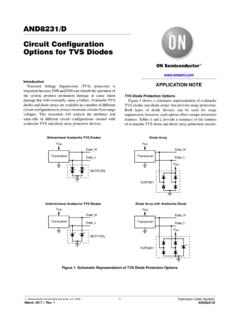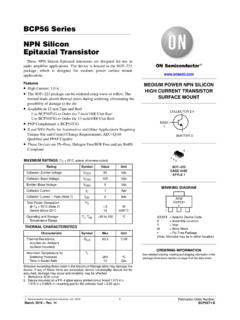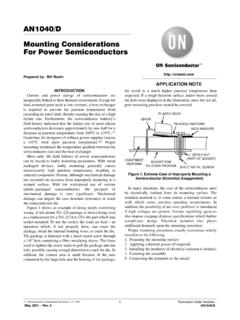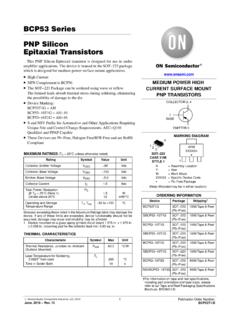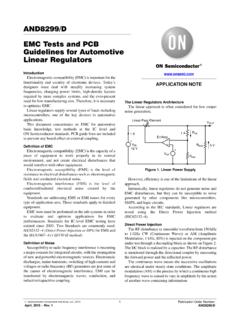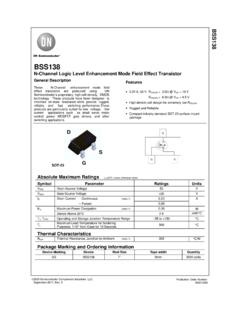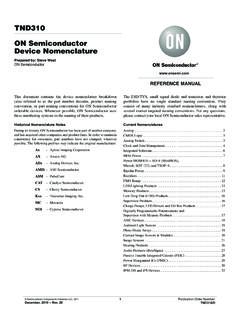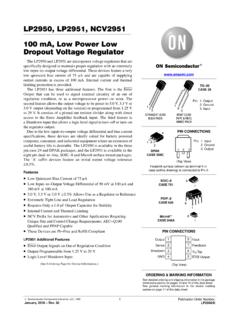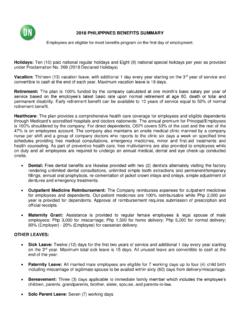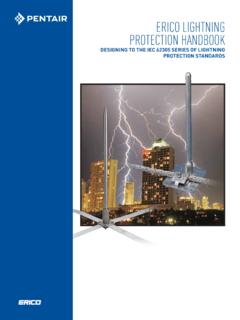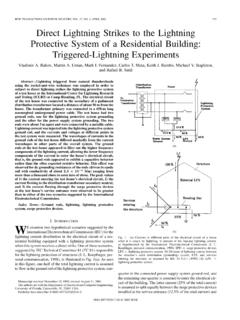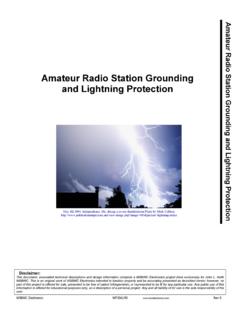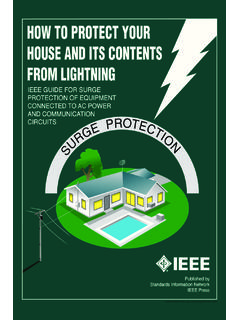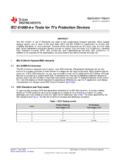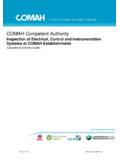Transcription of Transient Overvoltage Protection - ON …
1 Semiconductor Components Industries, LLC, 2008 April, 2008 - Rev. 01 Publication Order Number:TND335/DTND335/DRev. 0, APR - 2008 Transient Overvoltage Protection Page 1 of 40 | TND335 | Chapter 1. The Nature of the Transient Overvoltage Problem overview of Hazards Electrical transients in the form of voltage surges have always existed in electrical distribution systems, and prior to the implementation of semiconductor devices, they were of minor concern. The vulnerability of semiconductors to lightning strikes was first studied by Bell Laboratories in 1961. [1] A later report tried to quantify the amount of energy certain semiconductors could absorb before they suffered latent or catastrophic damage from electrostatic discharge. [2] Despite these early warnings, industry did not begin to address the issue satisfactorily until the late 1970s. All electrical and electronic devices can be damaged by voltage transients.
2 The difference between them is the amount of energy they can absorb before damage occurs. Because many modern semiconductor devices, such as low voltage MOSFETs and integrated circuits can be damaged by disturbances that exceed only 10 volts or so, their survivability is poor in unprotected environments. In many cases, as semiconductors have evolved, their ruggedness has diminished. The trend to produce smaller and faster devices, and the spread of MOSFET and gallium arsenide FET technologies has led to an increased vulnerability. High impedance inputs and small junction sizes limit the ability of these devices to absorb energy and to conduct large currents. It is necessary, therefore, to supplement vulnerable electronic components with devices specially designed to cope with these hazards. Selection of the proper protective method should be made based upon a thorough investigation of the potential sources of the Overvoltage hazard.
3 Different applications and environments present different sources of Overvoltage . The sources may be external, or they may be within the circuit. Lightning At any given time there are about 1800 thunderstorms in progress around the world, with lightning striking about 100 times each second. In the U. S., lightning kills about 150 people each year and injures another 250. In flat terrain with an average lightning frequency, each 300 foot structure will be hit, on average, once per year. Each 1200 foot structure, such as a radio or TV tower, will be hit 20 times each year, with strikes typically generating 600 million volts. Each cloud-to-ground lightning flash really contains from three to five distinct strokes occurring at 60 millisecond intervals, with a peak current of some 20,000 Amperes for the first stroke and about half that for subsequent strokes. The final stroke may be followed by a continuing current of around 150 Amps lasting for 100 milliseconds.
4 Page 2 of 40 | TND335 | The rise time of these strokes has been measured to be around 200 nanoseconds or faster. It is easy to see that the combination of 20,000 Amps and 200 nanoseconds calculates to a value, dI/dt, of 1011 Amps per second! This large value means that Transient Protection circuits must use radio frequency (RF) design techniques, particularly considerate of parasitic inductance and the capacitance of the conductors. While this peak energy is certainly impressive, it is really the longer term continuing current which carries the bulk of the charge transferred between the cloud and ground. From various field measurements, a typical lightning model has been constructed, as shown in Figure 1. Figure 1 Typical Lightning Model, With and Without Continuing Current Depending on various conditions, continuing current may or may not be present in a lightning strike.
5 A severe lightning model has also been created, which gives an indication of the strength which can be expected during worst case conditions at a point very near the strike location. Figure 2 shows this model. Note that continuing current is present at more than one interval, greatly exacerbating the damage which can be expected. A severe strike can be expected to ignite combustible materials. A direct hit by lightning is, of course, a dramatic event, and probably non-recoverable. In fact, the electric field strength of a lightning strike some distance away may be excessive enough to cause catastrophic or latent damage to semiconductor equipment. It is a more realistic venture to try to protect equipment from these nearby strikes than to expect survival from a direct hit. Page 3 of 40 | TND335 | Figure 2 Severe Lightning Model With this in mind, it is important to be able to quantify the induced voltage as a function of distance from the strike.
6 Figure 3 shows that these induced voltages can be quite high, explaining the destruction of equipment from relatively distance lightning flashes. Figure 3 Voltage Induced by Nearby Lightning Strike Burying cables does not provide appreciable Protection as the earth is almost transparent to lightning radiated fields. In fact, underground wiring has a higher incidence of strikes than aerial cables.[3] Protection against such hazards is a necessity for wired telecommunications. Primary Protection devices such as carbon blocks and gas tubes have historically provided some degree of safety. Secondary and board-level Protection has become the domain of a variety of semiconductor devices, including thyristor surge Protection devices (TSPD). These are used at the termination of long wiring runs, for example on central office line Page 4 of 40 | TND335 | cards, modems, etc.
7 TSPD Protection devices and techniques will be detailed in later chapters of this document. Switching of Loads in Power Circuits Inductive switching transients occur when a reactive load, such as a motor, solenoid or relay coil, is switched off. The rapidly collapsing magnetic field induces a Transient voltage across an inductive load s winding which can be expressed by the formula: V = - L (dI/dt) where L is inductance in henrys and dI/dt is the rate of change of current in Amps per second. Such transients can occur from a power failure, the normal opening of a switch or a load failure. The energy associated with the Transient is that stored within the inductance at power interruption and is equal to: = 1/2 Li2 where is energy in joules and I is instantaneous current in amps at the time of interruption. As an example, a to kilovolt (kV) peak Transient can be injected into a 120 volt ac (vac) power line when the ignition system of an oil furnace is fired.
8 It has also been shown that there are transients present on these lines which can reach as high as 6 kV. In locations without Transient Protection devices, the maximum Transient voltage is limited to about 6 kV by the insulation breakdown of the wiring. Inductive switching transients are the silent killers of semiconductors as they often occur with no outward indication. A graphic example is the report of a large elevator company indicating the failure of 1000 volt rectifiers during a power interruption. In another area, power interruption to a 20 horsepower (HP) pump motor in a remote area was directly related to failure of sensitive monitoring equipment at that same site. [4] The International Electrotechnical Commission (IEC) is now promoting their specification IEC 61000-4-4. This describes an inductive switching Transient voltage threat having 50 nanosecond wide spikes with amplitudes from 2 kV to 4 kV occurring in 300 millisecond wide bursts.
9 Besides these particular regulatory specifications, many other application specific, functional tests exist. A supplier of Transient voltage suppressor (TVS) components will be expected to perform to a wide variety of them. These components must be robust, because the hazard is dynamic and generally repetitive. TVS Protection devices and techniques will be detailed in Chapter 2 of this document. Page 5 of 40 | TND335 | Electrostatic Discharge (ESD) Electrostatic discharge (ESD) is a widely recognized hazard during manufacturing, shipping and handling of many semiconductor devices, especially those that contain unprotected MOSFETs, semiconductors for use at microwave frequencies and very high speed logic with switching times of 2 nanoseconds or less. In response to this threat, most semiconductors are routinely shipped in containers made of conductive material. This technique essentially maintains a common electrical potential between the device pins, eliminating any voltage differential.
10 In addition to various shipping precautions, electronic assembly line workers should be grounded, use grounded-tip soldering irons, ionized air blowers and other techniques to prevent large voltage potentials to be generated and possibly discharged into the semiconductors they are handling. Testing of the device presents yet another opportunity for static buildup and discharge. Once the finished device is in normal operation, ESD damage can still occur. Any person shuffling his feet on a carpet and then touching a computer keyboard can possibly cause a software crash or, even worse, damage the computer hardware. The electrical waveform involved in ESD is a brief pulse, with arise time of about nanosecond, and a duration of 100 to 300 microseconds. The peak voltage can be as large as 30 kV in dry weather, but is more commonly to The fastest rise times occur from discharges originating at the tip of a hand-held tool, while discharges from the finger tip and the side of the hand are slightly slower.
